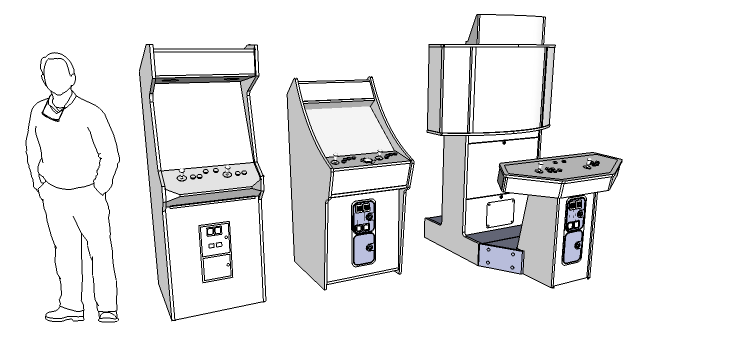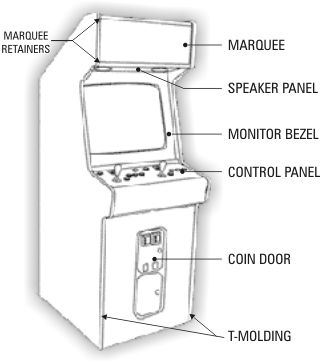Arcade Cabinet
This article provides an introduction to Arcade cabinets including an overview of the basic cabinet types.
Contents
Type of Cabinents
Cabinets can be divided into a few basic categories:
Upright/Standard cabinet
The standard upright cabinet is the most common cabinet. The player stands or is seated in front of the cabinet. Multiple cabinets of this type can be lined up against a wall to save space and still be playable.
- Regular, the iconic, archetype, arcade cabinet. The monitor is usually above waist height with the marquee overhanging.
- Cabaret, a slightly smaller version of the regular cabinet. The marquee is often located between the control panel and coin door.
- Low-boy, a standup cabinet where the marquee is in the same plane as the monitor making the cabinet much lower, hence the name.
- Pedestal, a arcade where the screen is not part of the arcade setup. The monitor could be a TV or projection attached to a wall.
- Showcase, a setup where the screen is in a separate housing as the control panel but still visually part of one setup. Setups like this usually feature a large screen positioned in such way that onlookers may view the action. The 'showcase' may both refer to the player being able to showcase his or her gaming skill as to the elaborate arcade setup itself.
Examples: Upright cabinets
Cocktail cabinet
The cocktail cabinet is basically a table with a screen in it. This cabinet is usually fitted with controls for two or more players, each sitting at opposite sides of the table. Some games are designed with this kind of play in mind (players sitting opposite of each other) while other games 'flip' the screen to alernate between players.
Examples: Cocktail cabinets
Driving/Sitdown cabinet
The driving/sitdown cabinet mimics the driver's cockpit (or pilot's, depending on the game) with a steering wheel, flight yoke, motorcycle handlebars etc as main controls. These cabinets may feature a shifter, stick shift, throttle and/or brake pedals. Elaborate sitdown cabinets are powered by hydraulics to mimic the player's movement as seen on a screen. One of the most elaborate sitdown cabinets is R-360 cabinet.
Examples: Driving/Cockpit cabinets
Jukebox cabinets
A Jukebox cabinet is designed so that you can listen to your music using jukebox software. This type of cabinet does not require a joystick, just buttons or a touchscreen.
Examples: Jukeboxes
Bartop arcades
A bartop arcade is designed to be placed on a tabletop or bartop and generally is a smaller version of an arcade game cabinet.
Examples: Bartop/Countertop
Showcase cabinet
A showcase cabinet consists of two distinct sections. One section will house the video monitor and position it at eye level while standing, and the other section, called the pedestal, supports the control panel and raises it into position to be played while standing.
Specialized cabinets
A category of cabinets that are specific to the games they play. A good example of these are the Dance Dance Revolution cabinets that feature dance pads as controls.
Anatomy of a cabinet
Arcade cabinets vary in size and complexity but they generally comprise the same basic features as shown on the left.

